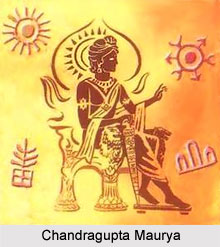 There is a great deal of controversy among the scholars regarding the origin of the Mauryans. Following are some of the different views regarding the origin of the Mauryans that are listed below.
There is a great deal of controversy among the scholars regarding the origin of the Mauryans. Following are some of the different views regarding the origin of the Mauryans that are listed below.
• According to Spooner, Mauryans were Persians because the social, religious and political conditions of India and Persia of that time were similar. But most of the scholars disagree with this view.
• According to the second view, which is based on Brahman literature, Mauryans were Shudras. Different Brahman books had given different versions about the Mauryans.
Purans: Along with the mention of the destruction of Shishunaga dynasty and establishment of Nanda dynasty, Puranas also mentions that after this Shudras will rule the country. However, this sentence is applicable to Nandas and after the destruction of Shishunaga dynasty there were several dynasties that were definitely Brahmanas. Hence the view does not seem to be correct.
Commentaries of Puranas: According to a commentator of Vishnu Puran, Chandra Gupta was the son of Nanda through a wife named Mura. But this view is not acceptable because nowhere in the purans, Chandra Gupta has been referred as belonging to Nanda dynasty. Moreover, according to Panini`s `Vyakaran`, the word `Maurya` has not originated from the word `Mura`.
Mudrarakshas: Vishakha Datta wrote `Mudrarakshas` between 6th and 8th century. `Mudrarakshas` mentions Chandra Gupta as son of Nanda king and is described as `Vrikhals`. According to some writers `Vrikhals` were Shudras but further study and research has shown that persons condemning caste system were called `Vrikhal`. Now here in one of the dramas Chandra Gupta has been described as son of Nanda through a legitimate wife. It, therefore, appears that the dramatist described him as the son of illegitimate wife of low caste.
`Katha sarit sagar` and `Brihat katha manjari`: These are written by Som Dev and Chhaemendra. `Katha sarit sagar` and `Bidhat katha manjari` respectively, describe Chandra Gupta as belonging to Nanda dynasty. But there are many ancient books and scholars. They doubt their authenticity.
Thus it can be seen that there are contradictory stories regarding the caste of Chandra Gupta.
Kautilya `Arthasastra`: According to Kautilya`s Arthasastra, Chanakya crowned Chandra Gupta after destroying the Nanda dynasty. Being a Brahman, Chanakya was a staunch follower of `Varnashram` system and would not consent to make a Shudra king in place of Nandas whom he had gone all out to destroy. Dr. Radha Kumud Mookerii says, "It is thus quite absurd to suppose that Kautliya who was out to rescue this dharma or system from the outrage inflicted upon it by a Shudra sovereignty, could have chosen as his agent in the fulfillment of his sacred mission a person of the same disqualification. He could not consecrate to sovereignty one Shudra in place of another."
Thus it is quite incorrect to say that the Mauryas were Shudra.
• According to the third view, Mauryans were Kshatriyas.
This view is based upon the following literature
Buddhist literature: The entire Buddhist literature describes Mauryans as Kshatriyas. According to `Mahavamsa`, Chandra Gupta was a Kshatriya called Maurya whom Chanakya crowned as king after putting an end of the Nanda dynasty. `Mahabodhi vamsa` describes Chandra Gupta as being born in the royal dynasty of Mariyanagara. There is also the mention of the Kshatriya clan known as the Mariyas of Pipphalivana in `Digha nikaya`. Moreover, `Divyadana` describes Bindusara was lawfully anointed Kshatriya king. There is a reference in `Mahaparinirvana`, which says that when lord Buddha attained nirvana, the mariyas of Pipphalivana sent a message. "You and we are Kshatriyas and so we also enjoy aright to have a share in the remains of lord Buddha." This quote further confirms that Mauryans were Kshatriyas.
Jain literature: According to `Parisistha parvana` written by Hem Chandra, Chandra Gupta belonged to a community who were famous as `rearers of royal peacocks`. Haribhara tika also lends its support to this view. `Punyashrava katha kosh` clearly mentions Chandra Gupta as Kshatriya.
Evidence of the foreigners: According to diodorus, "parus informed Alexander that the king of the gangaridai (nanda king) was a man of quite worthless character and held in no respect as he was thought to be the son of a barber." The famous historian, plutarch has written that androkottos or Chandra Gupta when he was only a young man had seen Alexander himself. He had told Alexander that he could easily win the Nanda king because people "hated and despised the king because of his low and mean origin. The great historian Justin also wrote about the humble birth of Chandra Gupta. But his reference of humble birth does not mean that he was a Shudra, what actually is meant is the weak economic conditions of the family of the Chandra Gupta.
Thus the foreign sources do not prove that Chandra Gupta was a Shudra or was of low origin.
Archeological evidence: The excavated portion of the Ashoka`s pillar at nandan garh contains an emblem of peacock. The stupa at Sanchi also has several statues of peacocks. Besides this, Ashoka`s inscriptions also mentions peacock. Thus it is also said that people living in lands full of peacocks, were called `Maurya`. So it can be inferred that the origin of the `Maurya` is not from the word `Mura`.
In view of the above statements and evidence supporting them, it can be concluded that Mauryas were not Sudras. The view that Mauryans were Kshatriyas does not only seem to be proper, reasonable and correct but there is sufficient reliable evidence to support it as well.



















